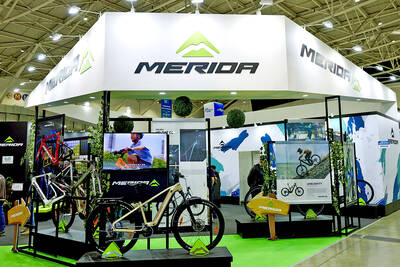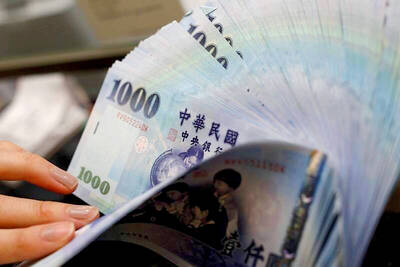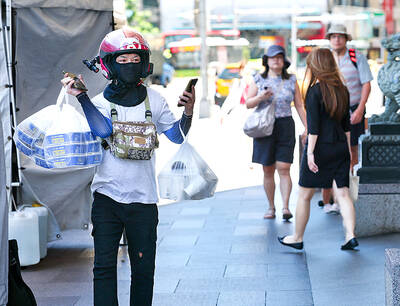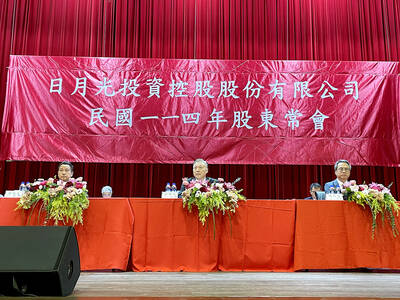Engineer Dallas Goecker attends meetings, jokes with colleagues and roams the office building just like other employees at his company in Silicon Valley.
However, Goecker is not in California. He is more than 3,700km away, working at home in Seymour, Indiana.
It is all made possible by the Beam — a mobile video-conferencing machine that he can drive around his company’s offices and workshops in Palo Alto. The 1.5m tall device, topped with a large video screen, gives him a physical presence that makes him and his colleagues feel like he is actually there.
“This gives you that casual interaction that you’re used to at work,” Goecker said, speaking on a Beam. “I’m sitting in my desk area with everybody else. I’m part of their conversations and their socializing.”
Suitable Technologies, which makes the Beam, is one of more than a dozen companies that sell so-called “telepresence” robots. The remote-controlled machines are equipped with video cameras, speakers, microphones and wheels allowing users to see, hear, talk and “walk” in faraway locations.
More employees are working remotely, thanks to computers, smartphones, e-mail, instant messaging and video-conferencing. However, those technologies are no substitute for actually being in the office, where casual face-to-face conversations allow for easy collaboration and camaraderie.
Telepresence-robot makers are trying to bridge that gap with wheeled machines — controlled over wireless Internet connections — that give remote workers a physical presence in the workplace.
These robotic stand-ins are still a long way from going mainstream, with only a small number of organizations starting to use them. The machines can be expensive, difficult to use and can even get stuck if they venture into areas with poor Internet connectivity. Stairs can be lethal, and non-techies might find them too strange to use regularly.
“There are still a lot of questions, but I think the potential is really great,” said Pamela Hinds, co-director of Stanford University’s Center on Work, Technology & Organization. “I don’t think face-to-face is going away, but the question is, how much face-to-face can be replaced by this technology.”
Technology watchers say these machines could be used for many purposes. They could let managers inspect overseas factories, salespeople greet store customers, family members check on elderly relatives or art lovers to tour museums.
Some physicians are already seeing patients in remote hospitals with the RP-VITA robot co-developed by Santa Barbara, California-based InTouch Health and iRobot, the Bedford, Massachusetts-based maker of the Roomba vacuum.
The global market for telepresence robots is projected to reach US$13 billion by 2017, said Philip Solis, research director for emerging technologies at ABI Research.
The robots have attracted the attention of Russian venture capitalist Dimitry Grishin, who runs a US$25 million fund that invests in early-stage robotics companies.
“It’s difficult to predict how big it will be, but I definitely see a lot of opportunity,” Grishin said. “Eventually it can be in each home and each office.”
The Beam got its start as a side project at Willow Garage, a robotics company in Menlo Park where Goecker worked as an engineer.
A few years ago, he moved back to his native Indiana to raise his family, but found it difficult to collaborate with colleagues using existing video-conferencing systems.
“I was struggling with really being part of the team,” Goecker said. “They were doing all sorts of wonderful things with robotics. It was hard for me to participate.”
So Goecker and his colleagues created their own telepresence robot. The result: the Beam and a new company to develop and market it, but at US$16,000 each, the Beam does not come cheap.
Suitable Technologies has embraced the Beam as a workplace tool. Up to half of its 25 employees “beam” into work, with those on Beams sitting next to their flesh-and-blood colleagues and even joining them for lunch in the cafeteria.

Merida Industry Co (美利達) has seen signs of recovery in the US and European markets this year, as customers are gradually depleting their inventories, the bicycle maker told shareholders yesterday. Given robust growth in new orders at its Taiwanese factory, coupled with its subsidiaries’ improving performance, Merida said it remains confident about the bicycle market’s prospects and expects steady growth in its core business this year. CAUTION ON CHINA However, the company must handle the Chinese market with great caution, as sales of road bikes there have declined significantly, affecting its revenue and profitability, Merida said in a statement, adding that it would

RISING: Strong exports, and life insurance companies’ efforts to manage currency risks indicates the NT dollar would eventually pass the 29 level, an expert said The New Taiwan dollar yesterday rallied to its strongest in three years amid inflows to the nation’s stock market and broad-based weakness in the US dollar. Exporter sales of the US currency and a repatriation of funds from local asset managers also played a role, said two traders, who asked not to be identified as they were not authorized to speak publicly. State-owned banks were seen buying the greenback yesterday, but only at a moderate scale, the traders said. The local currency gained 0.77 percent, outperforming almost all of its Asian peers, to close at NT$29.165 per US dollar in Taipei trading yesterday. The

RECORD LOW: Global firms’ increased inventories, tariff disputes not yet impacting Taiwan and new graduates not yet entering the market contributed to the decrease Taiwan’s unemployment rate last month dropped to 3.3 percent, the lowest for the month in 25 years, as strong exports and resilient domestic demand boosted hiring across various sectors, the Directorate-General of Budget, Accounting and Statistics (DGBAS) said yesterday. After seasonal adjustments, the jobless rate eased to 3.34 percent, the best performance in 24 years, suggesting a stable labor market, although a mild increase is expected with the graduation season from this month through August, the statistics agency said. “Potential shocks from tariff disputes between the US and China have yet to affect Taiwan’s job market,” Census Department Deputy Director Tan Wen-ling

UNCERTAINTIES: The world’s biggest chip packager and tester is closely monitoring the US’ tariff policy before making any capacity adjustments, a company official said ASE Technology Holding Inc (日月光投控), the world’s biggest chip packager and tester, yesterday said it is cautiously evaluating new advanced packaging capacity expansion in the US in response to customers’ requests amid uncertainties about the US’ tariff policy. Compared with its semiconductor peers, ASE has been relatively prudent about building new capacity in the US. However, the company is adjusting its global manufacturing footprint expansion after US President Donald Trump announced “reciprocal” tariffs in April, and new import duties targeting semiconductors and other items that are vital to national security. ASE subsidiary Siliconware Precision Industries Co (SPIL, 矽品精密) is participating in Nvidia